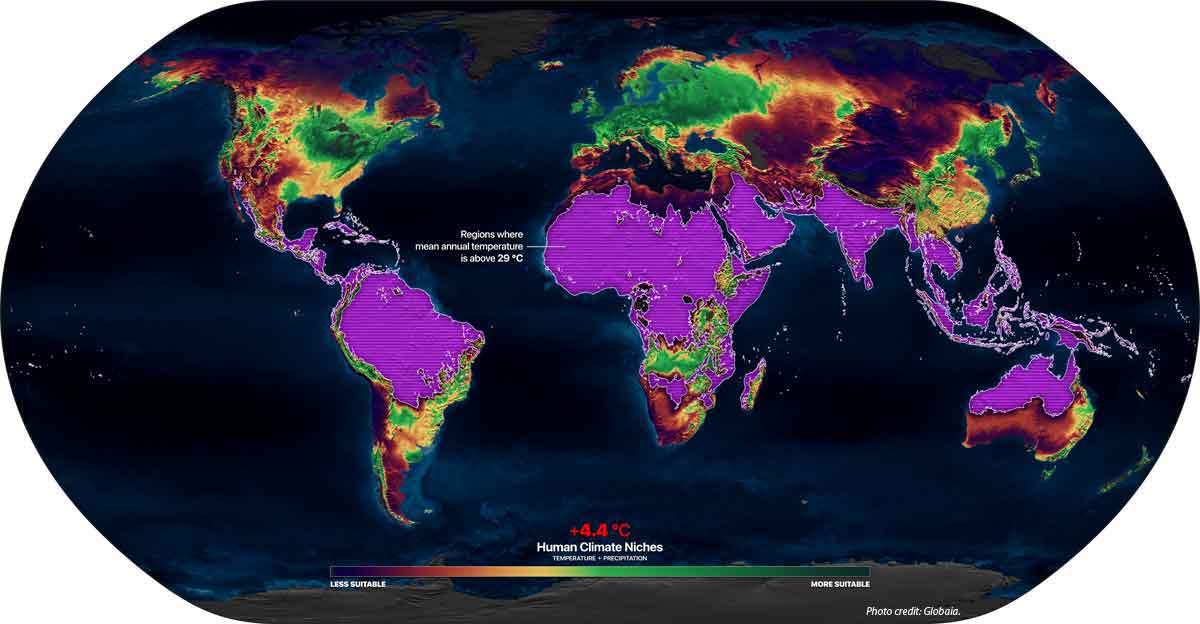
By Ashish Ghadiali, Director at Radical Ecology and Visiting Research Fellow at the University of Exeter, UK
Our 2023 study, quantifying the human cost of global warming (Lenton et al.)[1], connected projected temperature changes with corresponding population data to demonstrate the scale of impact that carbon reduction can have on extreme heat exposure through to the year 2100.
This new data shows that in the scenario where carbon emissions continue to rise, leading to global warming of +3.6˚C or even +4.4˚C above pre-industrial atmospheric temperatures, we could expect to see half the world’s population exposed to unprecedented levels of heat, a scenario that leading climate scientists have dubbed “existential”.
In the situation where current decarbonisation commitments play out, leading to a mean temperature rise of +2.7˚C, this reduces to one-fifth of the world’s population exposed – two billion people of which 600 million people in India and 300 million in Nigeria are projected to be displaced outside the human climate niche by 2100, while in a situation where carbon emissions reduction succeeds in limiting global warming to +1.5˚C, this figure is reduced to 5% of the world’s population exposed.
Rapid decarbonisation/mitigation, is therefore the primary goal for avoiding heatwave deaths as we move deeper into the 21st century. It demands a sea-change in international cooperation and diplomacy as well as in the mechanisms for climate and development finance that could adequately fund a just transition away from the fossil-fuel economy.
Professor Avinash Persaud, an architect of the Bridgetown Initiative, has called on the IMF to draw down $500 billion in special drawing rights that could leverage up to $5 trillion in private finance for mitigation[2]. However, in a context where escalating climate vulnerability makes access to finance increasingly difficult for developing countries, increased scale of mitigation funding must also be supported by a paradigm shift in the global financial architecture that, instead of penalising vulnerability, acknowledges the value in investing directly into it.
At the local level, planning and preparedness that is also supported by adequate budgetary provision can significantly reduce levels of heatwave mortality. Measures, including the development of early warning systems and communication networks, can help to ensure that vulnerable populations are informed and resourced in the face of heatwave impacts.
Investment in the adaption of the built environment through improved ventilation and urban forests and in labour conditions through flexible working times, and the provision of drinking water and food, rest arrangements and emergency medical services can support the resilience of outdoor workers and community stakeholders.
Blended finance, microinsurance, and debt suspension can all serve as instruments that will save those most adversely impacted by heatwaves from debilitating poverty cycles, where chronic poverty is, above all, the leading driver of heatwave mortality.[3]
[1] https://www.nature.com/articles/s41893-023-01132-6?utm_campaign=related_content&utm_source=EARTHENV&utm_medium=communities
[2] https://unclimatesummit.org/opinion-the-bridgetown-initiative/
[3] Valuing the Global Mortality Consequences of Climate Change Accounting for Adaptation Costs and Benefits https://www.nber.org/papers/w27599
Disclaimer: The views expressed in this piece are those of the author/s and do not necessarily reflect the views or policies of AIDMI.